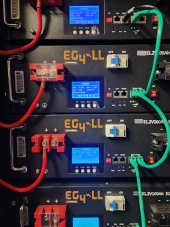BuckeyePower
New Member
- Joined
- Oct 22, 2022
- Messages
- 1

What was the outcome?.
So it's a USB to RJ45 cable ? Where did you get that from?No it is USB END
Did you actually click on the link provided and scroll all the way through that help screen? There's even a video in there showing you how to do it with your batteriesThat's not a good explanation, can you post a picture?
I'm not using eg4 gear but if it were me, I'd use a USB hub and home run all the inverters and all the batteries to the Raspberry PiA little off topic but similar...... Regarding direct connection to Raspberry PI of multiple EG4 inverters, would this be accomplished the same way (using rj45 splitters). Thanks
A little off topic but similar...... Regarding direct connection to Raspberry PI of multiple EG4 inverters, would this be accomplished the same way (using rj45 splitters). Thanks
I can't see the link, where is it?Did you actually click on the link provided and scroll all the way through that help screen? There's even a video in there showing you how to do it with your batteries
I did this connections exactly the same way,But the only thing I didn't do is disconnect the batteries communication cableDid you actually click on the link provided and scroll all the way through that help screen? There's even a video in there showing you how to do it with your batteries
And yet you expected a different outcome.I left it the same way
So you are saying disconnect the Batteries communication cables. And connect the RS485 to the splitters up to the solar assistant Raspberry pi,and from the solar assistant to the inverter. No changes to the dips switches? My (master)Battery DDDU,and the others are different settings and it should work.And yet you expected a different outcome.
Again, I don't have any EG for gear and I haven't watched that installation video on solar assistant's help page.So you are saying disconnect the Batteries communication cables. And connect the RS485 to the splitters up to the solar assistant Raspberry pi,and from the solar assistant to the inverter. No changes to the dips switches? My (master)Battery DDDU,and the others are different settings and it should work.
I am still working on getting my system to communicate fully so I'm not an expert. But. The addressing scheme for the batteries is kind of important for any functionality at all. If the addresses are wrong, nothing works, and you will get error 60 and 61 on eg4 inverters. Solar Assistant reads the batteries in order, and therefore also relies on addressing. EG4 addressing is odd to me, but the scheme is easy.Again, I don't have any EG for gear and I haven't watched that installation video on solar assistant's help page.
That being said if it were mine, I would take all the green connection cables off the batteries, I would put all the dip switches down, I would run a 485 to USB cable from battery one to a USB hub.
I would then run a 485 to USB cable from battery two to the same USB hub and battery three and battery 4 etc.
Then I would run a cable from the USB hub to the Raspberry Pi.
Then I would run a cable from each inverter to the Raspberry Pi. And see if that works.
It seems to me that you're trying to have both monitoring setups working simultaneously.
You've bought solar assistant so just surrender yourself to it.


